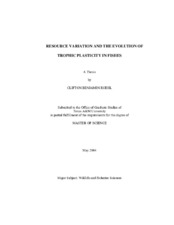| dc.contributor.advisor | DeWitt, Thomas J. | |
| dc.creator | Ruehl, Clifton Benjamin | |
| dc.date.accessioned | 2004-09-30T02:04:22Z | |
| dc.date.available | 2004-09-30T02:04:22Z | |
| dc.date.created | 2005-05 | |
| dc.date.issued | 2004-09-30 | |
| dc.identifier.uri | https://hdl.handle.net/1969.1/486 | |
| dc.description.abstract | Resource variation and species interactions require organisms to respond behaviorally, physiologically, and morphologically within and among generations to compensate for spatial and temporal environmental variation. One successful evolutionary strategy to mitigate environmental variation is phenotypic plasticity: the production of alternative phenotypes in response to environmental variation. Phenotypic plasticity yields multiple characters that may enable organisms to better optimize phenotypic responses across environmental gradients. In this thesis, I trace the development of thought on phenotypic plasticity and present two empirical studies that implicate phenotypic plasticity in producing morphological variation in response to resource variation. The first empirical study addresses trophic plasticity, population divergence, and the effect of fine-scale environmental variation in western mosquitofish (Gambusia affinis). Offspring from two populations were fed either attached or unattached food items offered in three orientations: (1) water surface, (2) mid-water, (3) benthic, and (4) a daily rotation of the former three (fine-grained variation). Attached food induced wide heads, blunt snouts and rounded pectoral fins relative to morphology in the unattached treatment. Mid-water feeding induced elongated heads and deeper mid-bodies relative to benthic and surface feeding induced morphologies. The rotating treatment produced intermediate morphologies. Population divergence seemed related to both trophic and predation ecology. Ecomorphological consequences of induced morphologies and the need for inclusion of greater ecological complexity in studies of plasticity are discussed. The second study examines induced morphological plasticity and performance in red drum (Sciaenops ocellatus). I fed hatchery fish either hard or soft food for two months. Performance trials were designed to measure their ability to manipulate and consume hard food items. External morphology and the mass of pharyngeal crushing muscles were assessed for variation among treatments. A hard food diet induced deeper bodies and larger heads, more massive pharyngeal muscles, and initially more efficient consumption of hard food than fish receiving soft food. The observed morphological variation is in accordance with variation among species. Determining evolutionary mechanisms operating within red drum populations should eventually aid in developing and optimizing conservation efforts and ease the transition from hatchery facilities to estuaries. | en |
| dc.format.extent | 683283 bytes | en |
| dc.format.extent | 160837 bytes | en |
| dc.format.medium | electronic | en |
| dc.format.mimetype | application/pdf | |
| dc.format.mimetype | text/plain | |
| dc.language.iso | en_US | |
| dc.publisher | Texas A&M University | |
| dc.subject | resource polymorphism | en |
| dc.subject | trophic plasticity | en |
| dc.subject | ecomorphology | en |
| dc.subject | foraging ecology | en |
| dc.subject | geometric morphometrics | en |
| dc.subject | population differentiation | en |
| dc.subject | induced morphology | en |
| dc.subject | fine grained resource variation | en |
| dc.title | Resource variation and the evolution of phenotypic plasticity in fishes | en |
| dc.type | Book | en |
| dc.type | Thesis | en |
| thesis.degree.department | Wildlife and Fisheries Sciences | en |
| thesis.degree.discipline | Wildlife and Fisheries Sciences | en |
| thesis.degree.grantor | Texas A&M University | en |
| thesis.degree.name | Master of Science | en |
| thesis.degree.level | Masters | en |
| dc.contributor.committeeMember | Pinckney, James L. | |
| dc.contributor.committeeMember | Winemiller, Kirk O. | |
| dc.type.genre | Electronic Thesis | en |
| dc.type.material | text | en |
| dc.format.digitalOrigin | born digital | en |


